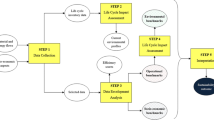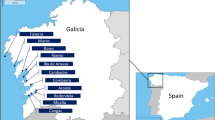Abstract
Background, aim, and scope
The synergistic use of life cycle assessment (LCA) and data envelopment analysis (DEA) is proposed as a new methodological approach to link environmental and socioeconomic assessments of fisheries. Therefore, the goal is to combine LCA and DEA in order to increase the assessment ability of both tools when applied to these fisheries. Specifically, the joint inclusion of economic aspects and the consideration of currently underrepresented environmental impact categories are tackled.
Materials and methods
A five-step method is presented to combine LCA and DEA so that operational benchmarking and eco-efficiency verification are included together with the assessment of the environmental performance of fishing vessels. Some guidelines are also provided to orientate methodological choices in DEA. Furthermore, the applicability of the method for fisheries is discussed using a Spanish coastal trawl fishery as an example.
Results
The use of the five-step LCA+DEA method for fisheries demonstrated the dependence of environmental impacts on the operational performance of the vessels. Operational inefficiencies were detected and target performance improvement values were consequently defined for the inefficient vessels. The combined method favored quantification of potential eco-efficiency gains. Optional features of DEA models allowed the inclusion of controversial impact issues such as by-catch discarding.
Discussion
As demonstrated by the application of the method to the trawling case study, this methodology facilitates joint consideration of the environmental impacts of the fleet together with economic issues such as operational efficiency. Moreover, the potential inclusion of “bad outputs” in DEA models makes the proposed method suitable for quantifying the potential improvements in currently underrepresented issue areas such as discarding by-catch.
Conclusions
The proposed methodological approach was found as an adequate alternative to complement the mere use of LCA for fisheries. Its use avoids problems with standard deviations which usually arise when LCA practitioners work with average inventories. Moreover, the new approach facilitates the interpretation of the results for practitioners who deal with multiple individual LCAs for the same fishery. Furthermore, the joint application of LCA and DEA carry synergistic effects related to the link between operational efficiency and environmental impacts.
Recommendations and perspectives
The proposed LCA+DEA approach for fisheries is recommended for its regular use. The need of multiple input/output data for multiple vessels is not seen as a limitation in the case of fisheries research.



Similar content being viewed by others
References
Ayer N, Côté RP, Tyedmers PH, Willison JHM (2009) Sustainability of seafood production and consumption: an introduction to the special issue. J Clean Prod 17:321–324
Banker RD (1984) Estimating most productive scale size using data envelopment analysis. Eur J Oper Res 17:35–44
Cooper WW, Seiford LM, Tone K (2007) Data envelopment analysis: a comprehensive text with models, applications, references and DEA-Solver Software. Springer, Berlin
Dalgaard R, Halberg N, Kristensen IS, Larsen I (2004) An LC inventory based on representative and coherent farm types. In: Halberg N (ed) Life cycle assessment in the agri-food sector. Proceedings from the 4th International Conference, October 5–8, 2003, Bygholm, Denmark. Danish Institute of Agricultural Sciences. DIAS report, Animal Husbandry 61:98–106
Dalgaard R, Halberg N, Kristensen IS, Larsen I (2006) Modelling representative and coherent Danish farm types based on farm accountancy data for use in environmental assessments. Agric Ecosyst Environ 117(4):223–237
Ekvall T, Tillman AM, Molander S (2005) Normative ethics and methodology for life cycle assessment. J Clean Prod 13:1225–1234
FAO (2008) World review of fisheries and aquaculture. FAO, Rome
Frischknecht R, Jungbluth N, Althaus HJ, Doka G, Heck T, Hellweg S, Hischier R, Nemecek T, Rebitzer G, Spielmann M, Wernet G (2007) Overview and methodology. ecoinvent report no. 1, Swiss Centre for Life Cycle Inventories, Dübendorf
Goedkoop M, De Schryver A, Oele M (2008) Introduction to LCA with SimaPro. PRé Consultants, The Netherlands
Guinée JB, Gorrée M, Heijungs R, Huppes G, Kleijn R, de Koning A, van Oers L, Wegener A, Suh S, Udo de Haes HA (2001) Life cycle assessment. An operational guide to the ISO standards. Centre of Environmental Science, Leiden, The Netherlands
Hospido A, Tyedmers P (2005) Life cycle environmental impacts of Spanish tuna fisheries. Fish Res 76:174–186
Iles A (2007) Making the seafood industry more sustainable: creating production chain transparency and accountability. J Clean Prod 15:577–589
ISO (2006a) ISO 14040 Environmental management—life cycle assessment—principles and framework
ISO (2006b) ISO 14044 Environmental management—life cycle assessment—requirements and guidelines
Kortelainen M (2008) Dynamic environmental performance analysis: a Malmquist index approach. Ecol Econ 64:701–715
Kuosmanen T, Kortelainen M (2005) Measuring eco-efficiency of production with data envelopment analysis. J Ind Ecol 9(4):59–72
Kuosmanen T, Kortelainen M (2007) Eco-efficiency analysis of consumer durables using absolute shadow prices. J Prod Anal 28:57–69
Lozano S, Iribarren D, Moreira MT, Feijoo G (2009) The link between operational efficiency and environmental impacts. A joint application of life cycle assessment and data envelopment analysis. Sci Total Environ 407:1744–1754
Lozano S, Iribarren D, Moreira MT, Feijoo G (2010) Environmental impact efficiency in mussel cultivation. Resour Conserv Recy (in review)
Luten J, Jacobsen C, Bekaert K, Saebø A, Oehlenschläger J (2006) Seafood research from fish to dish—quality, safety and processing of wild and farmed seafood. Wageningen Academic Publishers, Wageningen
Pauly D, Alder J, Bennett E, Christensen V, Tyedmers P, Watson R (2003) The future for fisheries. Science 302(5649):1359–1361
Pelletier NL, Ayer NW, Tyedmers PH, Kruse SA, Flysjo A, Robillard G, Ziegler F, Scholz AJ, Sonesson U (2007) Impact categories for life cycle assessment research of seafood production systems: review and prospectus. Int J Life Cycle Assess 12(6):414–421
Reap J, Roman F, Duncan S, Bras B (2008a) A survey of unresolved problems in life cycle assessment—part 2: impact assessment and interpretation. Int J Life Cycle Assess 13:374–388
Reap J, Roman F, Duncan S, Bras B (2008b) A survey of unresolved problems in life cycle assessment—part 1: goal and scope and inventory analysis. Int J Life Cycle Assess 13:290–300
Ruttan LM, Tyedmers PH (2007) Skippers, spotters and seiners: analysis of the “skipper effect” in US menhaden (Brevoortia spp.) purse-seine fisheries. Fish Res 83:73–80
Saitech (2009) http://www.saitech-inc.com/Products/Prod-DSP.asp
Schau EM, Ellingsen H, Endal A, Aanondsen SA (2009) Energy consumption in the Norwegian fisheries. J Clean Prod 17:325–334
Schmidheiny S (1992) Changing course—a global business perspective on development and the environment. World Business Council for Sustainable Development (WBCSD)
SOFIA (2008) The state of world fisheries and aquaculture. FAO, Rome
Thanassoulis E, Dyson RG (1992) Estimating preferred target input–output levels using data envelopment analysis. Eur J Oper Res 56:80–97
VDI-Richtlinien (1997) Cumulative energy demand—terms, definitions, methods of calculation. VDI-Richtlinien 4600, Düsseldorf (Germany)
Weidema BP, Wesnaes MS (1996) Data quality management for life cycle inventories—an example of using data quality indicators. J Clean Prod 4:167–174
Worm B, Hilborn R, Baum JK, Branch TA, Collie JS, Costello C, Fogarty MJ, Fulton EA, Hutchings JA, Jennings S, Jensen OP, Lotze HK, Mace PM, McClanahan TR, Minto C, Palumbi SR, Parma AM, Ricard D, Rosenberg AA, Watson R, Zeller D (2009) Rebuilding global fisheries. Science 325(5940):578–585
Xunta de Galicia (2008) Fishing technologic platform. www.pescadegalicia.com (in Galician)
Zhu J (2002) Quantitative models for performance evaluation and benchmarking: data envelopment analysis with spreadsheets and DEA Excel Solver. Springer, Berlin
Ziegler F, Valentinsson D (2008) Environmental life cycle assessment of Norway lobster (Nephrops norvegicus) caught along the Swedish west coast by creels and conventional trawls—LCA methodology with case study. Int J Life Cycle Assess 13:487–497
Ziegler F, Nilsson P, Mattsson B, Walther Y (2003) Life cycle assessment of frozen cod fillets including fishery-specific environmental impacts. Int J Life Cycle Assess 8(1):39–47
Acknowledgments
D. Iribarren wishes to thank the Spanish Ministry of Education for financial support (grant reference: AP2006-03904). The authors would like to thank all the anonymous skippers and sailors who kindly agreed to answer the questions proposed in the questionnaires, as well as the anonymous reviewers for their constructive comments and suggestions.
Author information
Authors and Affiliations
Corresponding author
Additional information
Responsible editor: Niels Jungbluth
Rights and permissions
About this article
Cite this article
Vázquez-Rowe, I., Iribarren, D., Moreira, M.T. et al. Combined application of life cycle assessment and data envelopment analysis as a methodological approach for the assessment of fisheries. Int J Life Cycle Assess 15, 272–283 (2010). https://doi.org/10.1007/s11367-010-0154-9
Received:
Accepted:
Published:
Issue Date:
DOI: https://doi.org/10.1007/s11367-010-0154-9




